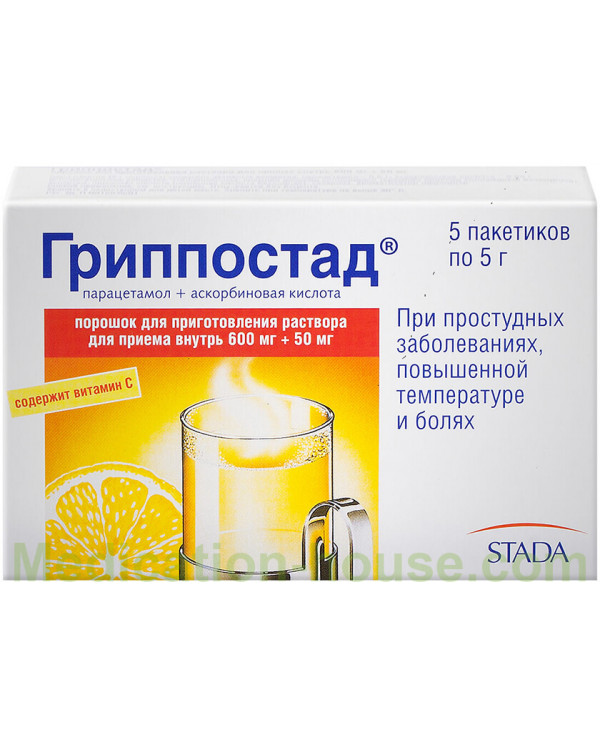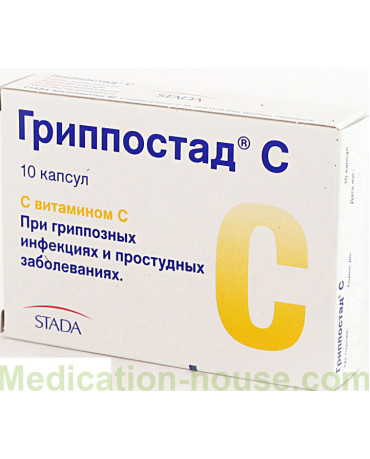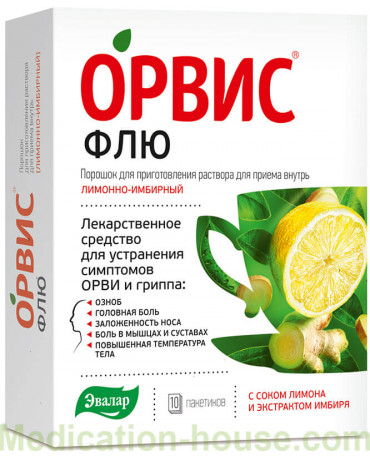Grippostad instruction
You can buy Grippostad here
pharmachologic effect
The combined drug.
Paracetamol has an analgesic (analgesic) and antipyretic effect. Non-narcotic analgesic, blocks cyclooxygenase types I and II, mainly in the central nervous system, affecting the centers of pain and thermoregulation. In inflamed tissues, cellular peroxidases neutralize the effect of paracetamol on cyclooxygenase, which explains the almost complete absence of an anti-inflammatory effect. The absence of a blocking effect on the synthesis of prostaglandins in peripheral tissues leads to the absence of a negative effect on water-salt metabolism (delay of sodium and water ions) and the mucous membrane of the gastrointestinal tract.
Ascorbic acid is involved in the regulation of redox processes, carbohydrate metabolism, blood coagulation, tissue regeneration (recovery), and in the synthesis of steroid hormones; increases the body's resistance to infections, reduces vascular permeability, reduces the need for vitamins B1, B2, A, E, folic acid, pantothenic acid. It improves the tolerance of paracetamol and lengthens its effect (slowing down its excretion).
Pharmacokinetics
Paracetamol
Suction and distribution
When taking Grippostad inside, paracetamol is rapidly and completely absorbed. Cmax in plasma is achieved 30-60 minutes after ingestion.
Paracetamol is rapidly distributed to all tissues. Blood, plasma, and saliva have comparable concentrations. Communication with plasma proteins is low. Penetrates through the BBB. Less than 1% of the dose of paracetamol taken by the nursing mother passes into breast milk.
Metabolism and excretion
It is metabolized in the liver in three main ways: conjugation with glucuronides, conjugation with sulfates, oxidation with microsomal liver enzymes. In the latter case, toxic intermediate metabolites are formed, which are subsequently conjugated with glutathione, and then with cysteine and mercapturic acid. The main isoenzymes of cytochrome P450 for this metabolic pathway are the isoenzyme CYP2E1 (predominantly), CYP1A2, and CYP3A4 (secondary role). With glutathione deficiency, these metabolites can cause damage and necrosis of hepatocytes.
Additional metabolic pathways include hydroxylation to 3-hydroxyparacetamol and methoxylation to 3-methoxyparacetamol, which are subsequently conjugated to glucuronides or sulfates.
In adults, glucuronidation predominates, in newborns (including premature infants) and young children - sulfation. Conjugated paracetamol metabolites (glucuronides, sulfates and conjugates with glutathione) have low pharmacological (including toxic) activity.
Paracetamol is mainly excreted in the urine. 90% of the absorbed amount is excreted through the kidneys within 24 hours, mainly in the form of metabolites: glucuronides (60-80%) and sulfates (20-30%). Less than 5% is excreted unchanged. T1 / 2 - 1-4 hours. T1 / 2 can be extended in cases of liver and kidney disease, in case of overdose and in newborns. The maximum effect and average duration of action (4-6 hours) approximately correlates with plasma concentration.
In patients with severe renal failure (CC less than 10 ml / min), the excretion of paracetamol and its metabolites is slowed down.
Vitamin C
Suction and distribution
Ascorbic acid is absorbed in the digestive tract (mainly in the jejunum). With an increase in dose to 200 mg, it is absorbed to 140 mg (70%); with a further increase in dose, absorption decreases (50-20%). Communication with plasma proteins - 25%. The concentration of ascorbic acid in plasma is normally about 10-20 μg / ml, the body's reserves are about 1.5 g when taking the daily recommended doses and 2.5 g when taking 200 mg / day. The time to reach Cmax after oral administration is 4 hours.
It easily penetrates into white blood cells, platelets, and then into all tissues; the highest concentration is achieved in the glandular organs, white blood cells, liver and lens of the eye; crosses the placenta. The concentration of ascorbic acid in leukocytes and platelets is higher than in red blood cells and in plasma.
Metabolism and excretion
It is metabolized mainly in the liver to deoxy-ascorbic acid and then to oxaloacetic and ascorbate-2-sulfate.
It is excreted by the kidneys, through the intestines, with sweat, breast milk in unchanged form and in the form of metabolites.
Indications
- febrile syndrome on the background of colds;
- pain syndrome of mild to moderate severity: arthralgia, myalgia, neuralgia, migraine, toothache and headache, algomenorrhea (painful menstruation).
Contraindications
- hypersensitivity (increased sensitivity to the components of Grippostad);
- bleeding in the digestive tract;
- portal hypertension (increased blood pressure in the portal vein);
- deficiency of glucose-6-phosphate dehydrogenase;
- phenylketonuria;
- Severe impairment of liver and kidney function;
- diseases of the blood system (anemia, thrombocytopenia, leukopenia);
- children under 12 years old and patients weighing less than 40 kg.
With caution: impaired liver and kidney function, Gilbert syndrome, Dubin-Johnson and Rotor syndrome, viral hepatitis, alcoholism (alcoholic liver damage), advanced age, concomitant use of other paracetamol-containing drugs.
Side effects
Allergic reactions (skin rash, itching, urticaria, angioedema), nausea, epigastric pain; anemia, thrombocytopenia, agranulocytosis.
With prolonged use in large doses - hepatotoxic and nephrotoxic effects; violation of blood formation.
Overdose
Symptoms: during the first 24 hours after administration - pallor of the skin, nausea, vomiting, anorexia, abdominal pain; impaired glucose metabolism, metabolic acidosis. Symptoms of liver dysfunction may appear 12-48 hours after an overdose. In severe overdose - liver failure with progressive encephalopathy, coma, death; acute renal failure with tubular necrosis (including in the absence of severe liver damage); arrhythmia, pancreatitis. Hepatotoxic effect in adults is manifested when taking 10 g or more.
Treatment: the introduction of SH-group donors and glutathione precursors - methionine - within 8-9 hours after an overdose and acetylcysteine - within 8 hours. The need for additional therapeutic measures (further administration of methionine, iv administration of acetylcysteine) is determined depending on the concentration of paracetamol in the blood, as well as the time elapsed after its administration.
special instructions
Patients with diabetes should be aware that 1 packet of Grippostad contains almost 3.8 g of sucrose (approximately 0.38 bread units).
Taking Grippostad distorts the performance of laboratory tests in the quantitative determination of glucose and uric acid in plasma.
Concomitant use with ethanol (including ethanol-containing drinks) is not recommended.
Influence on the ability to drive vehicles and control mechanisms
Taking Grippostad does not affect the speed of mental and motor reactions, so there is no need to refrain from driving vehicles and engaging in other activities that require an increased concentration of attention and speed of psychomotor reactions
With renal failure
Caution: impaired renal function.
With impaired liver function
Precautions: impaired liver function.
Elderly
Precautions: advanced age.
Pregnancy and lactation
There are no data on studies of the effectiveness and safety of the combination of paracetamol and ascorbic acid in pregnant and lactating women. Thus, it is not possible to assess the possible ratio of risk and benefit, and therefore the use of Grippostad in these categories of patients is not recommended.
Drug interaction
Other drugs containing paracetamol, as well as other non-narcotic analgesics, NSAIDs (metamizole sodium, acetylsalicylic acid, ibuprofen, etc.), barbiturates, antiepileptic drugs, rifampicin, chloramphenicol should not be used simultaneously.
Prolonged concomitant use of paracetamol and other non-steroidal anti-inflammatory drugs increases the risk of developing analgesic nephropathy and renal papillary necrosis, the onset of end-stage renal failure.
The simultaneous long-term administration of high doses of paracetamol and salicylates increases the risk of developing kidney or bladder cancer.
Diflunisal increases the plasma concentration of paracetamol by 50% - the risk of hepatotoxicity.
Myelotoxic drugs increase the hematotoxicity of Grippostad.
Inducers of microsomal liver enzymes (phenytoin, ethanol, barbiturates, rifampicin, phenylbutazone, tricyclic antidepressants) increase the production of hydroxylated active metabolites, which determines the possibility of severe intoxication with small overdoses.
Inhibitors of microsomal liver enzymes (cimetidine) reduce the risk of hepatotoxicity.
The simultaneous use of paracetamol and ethanol can enhance the hepatotoxicity of paracetamol, as well as contribute to the development of acute pancreatitis.
Reduces the effectiveness of uricosuric drugs.
Metoclopramide increases the absorption of paracetamol. Taking medications that slow down gastric emptying (for example, propantheline bromide) helps reduce the absorption of paracetamol.
Enhances the toxicity of chloramphenicol.
May enhance the effects of indirect anticoagulants.
Mode of application
The dose of paracetamol depends on age and body weight, in general 10-15 mg / kg of body weight once, the maximum daily dose is 60 mg / kg of body weight.
Taking the drug Grippostad can be repeated after 6-8 hours, i.e. 3-4 sachets per day. The interval between each dose should be at least 6 hours.
Do not exceed a single dose of Grippostad.
If at the same time the patient takes other paracetamol-containing drugs, the maximum allowable daily dose of paracetamol should not be exceeded (see table).
Patients with liver or kidney disease and Gilbert's syndrome: the dosage should be reduced or the interval between doses should be increased.
Patients with severe renal failure: in such cases (creatinine clearance less than 10 ml / min), the interval between doses should be at least 8 hours.
Elderly patients: no special dose adjustment is required.
The contents of one sachet should be poured into a glass, pour the necessary amount of hot water, mix and immediately drink the resulting warm drink. Use after meals may delay the onset of Grippostad.
Grippostad should not be used for more than 3 days without the recommendation of a doctor. It is necessary to consult a doctor if symptoms persist for more than 3 days.
Storage conditions and shelf life
The drug should be stored out of the reach of children at a temperature not exceeding 30 ° C. Shelf life is 5 years. Do not use the drug after the expiration date indicated on the package.
Terms of sell
You can buy Grippostad without a prescription.



